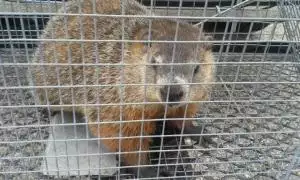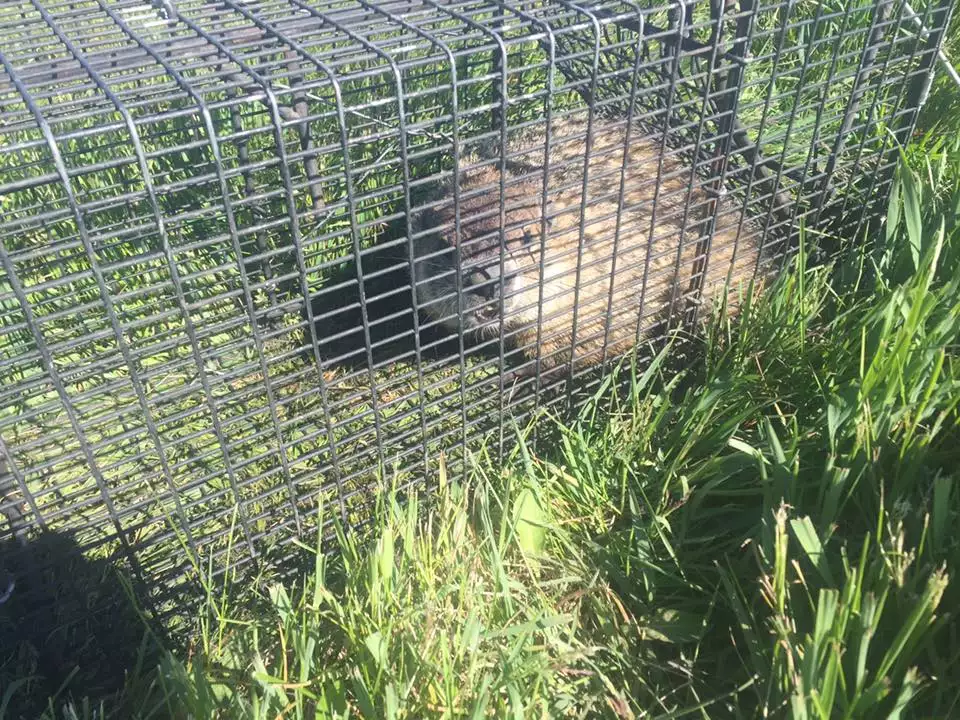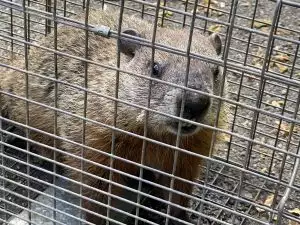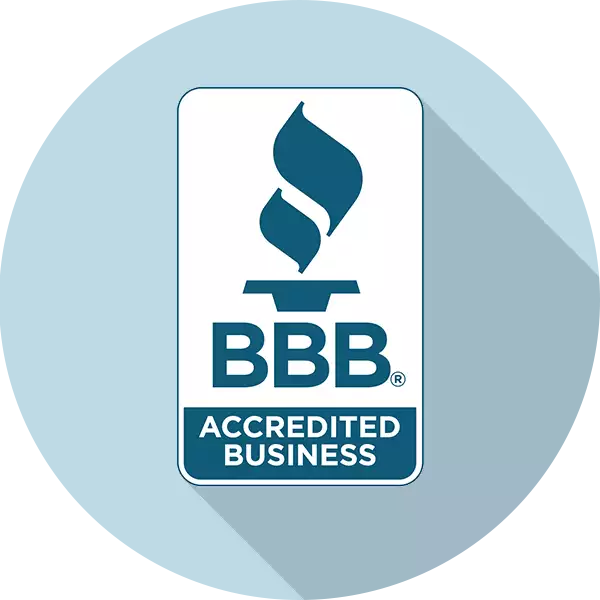Groundhog -Removal (Woodchucks)
Virginia Professional Wildlife Removal Services, LLC.
A full-service animal wildlife trapping, removal and pest control company – Licensed and Insured!

Groundhog Removal (Woodchucks)
Virginia Professional Wildlife Removal Services, LLC.
A full-service animal wildlife trapping, removal and pest control company – Licensed and Insured!

Virginia Professional Wildlife Removal Services, LLC. | Licensed & Insured
Providing Both Residential & Commercial Groundhog Removal Services
Groundhogs causing you problems? Have groundhogs gotten under your porch, shed or garage? Are those pesky woodchucks eating your plants and destroying your garden? No problem, groundhog removal and woodchuck control is our specialty.
While Punxsutawney Phil may be fun to watch every February 2nd, he is not much fun when he takes up residence in your yard, under your residence, or under one of your buildings. Virginia Professional Wildlife Removal Services provides nuisance groundhog removal and exclusions in Virginia – including Richmond, Charlottesville, Midlothian, Chesterfield, Glen Allen, Short Pump, Ashland, Goochland, Mineral, Gordonsville, Earlysville, Keswick, Louisa, Fluvanna, Orange, Albemarle, Amelia, Powhatan, Henrico and Hanover. Call us today and we will be happy to come out and help you with your unwelcome guests. While you’re waiting for us, you may want to learn a little about groundhogs and how they live.
At Virginia Professional Wildlife Removal Services we are constantly striving to advance our education so that we may serve you better.
The Groundhog, or Woodchuck, (Marmota Momax) is very prevalent throughout Virginia and is considered a nuisance species by the Virginia Department of Game and Inland Fisheries. They are diurnal animals, which means that they are most active in the morning and evening hours. They are usually a grizzled, brownish-gray, and weigh between 5 and 10 pounds and when startled will often emit a shrill whistle – which earned them the nickname “Whistlepig”. Most people are not aware that groundhogs are good climbers, and it is not unusual for them to climb trees.
Damage by groundhogs can range from mild to severe. They are often guilty of damaging vegetable and ornamental plants as well as shrubs and trees. Their diggings can undermine foundations, decks, driveways, swimming pools, and pond dams and dikes. They often chew on buried cables and wires and also building supports. Virginia Professional Wildlife Removal Services has handled several calls where a groundhog had been trapped inside a structure and had caused significant damage.
In late August and September, groundhogs have voracious appetites as they prepare to hibernate. This deep sleep, when body temperatures drop and heart rate slows to four beats per minute, usually begins in October and continues through February. They mate during March, shortly after emergence. In April four to five young are born. The young woodchucks remain in the den for about two months, leaving the nest in July to establish their own burrows and territories.
Removing a nuisance groundhog from your property does not have to be a sequel to the movie “Caddyshack”, call Virginia Professional Wildlife Removal Services today and let us handle the problem.
How To Get Rid Of Groundhogs – Marmot Prevention

Groundhog In Cage Trap
Groundhogs sometimes den in crawlspaces, so it is important to inspect the outside of the home for access points, such as broken vent covers or holes in the foundation. We have seen these critters completely destroy a homes HVAC system once they get into the crawlspace. Homeowners should seal all cracks and crevices with caulk, repair any loose siding and install a chimney cap over chimneys and other exposed openings. If an infestation is suspected, contact our licensed wildlife removal pest control professionals who can recommend the best method to get rid of a groundhog.
What Is The Difference Between Groundhogs, Woodchucks & Whistle Pigs?
There is no difference between a groundhog, woodchuck, whistle pig or marmot. In fact, the terms are interchangeable. This pesky critter is a member of the ground squirrel family.
Description of Damage
Groundhogs are also known as woodchucks. On occasion, the woodchuck’s feeding and burrowing habits conflict with human interests. Damage often occurs on farms, in home gardens, orchards, nurseries, around buildings, and sometimes around dikes. Damage to crops such as alfalfa, soybeans, beans, squash, and peas can be costly and extensive. Fruit trees and ornamental shrubs are damaged by woodchucks as they gnaw or claw woody vegetation. Gnawing on underground power cables has caused electrical outages. Damage to rubber hoses in vehicles, such as those used for vacuum and fuel lines, has also been documented. Mounds of earth from the excavated burrow systems and holes formed at burrow entrances present a hazard to farm equipment, horses, and riders. On occasion, burrowing can weaken dikes and foundations. (Source: Prevention and Control of Wildlife Damage, 1994)
Threats
Groundhogs are considered a nuisance pest because they can cause extensive damage to home gardens, farms, orchards and field crops as a result of their feeding and burrowing habits. When burrowing, they have been known to destroy building foundations, create unwanted holes on lawns and cause electrical outages from gnawing on underground wires. Horses have also been known to break their leg when stepping in a groundhog hole.
Health Concerns
The threat of contracting a disease from a woodchuck is very low. It has been documented that the woodchuck can carry several diseases, such as tularemia and sylvatic plague. Rodents are almost never found to be infected with the rabies virus. Woodchucks however are somewhat susceptible to the virus, and several have tested positive for the disease in Rhode Island. The most common way of human contraction of rabies is through pets or domesticated animals such as cats and dogs. Even though woodchucks pose little threat to humans one should always take precautions when dealing with wild animals. (Source: www.dem.ri.gov/programs/bnatres/fishwild/pdf/woodchuc.pdf)
Gopher Removal in Virginia
As of September 2021, gophers (the term commonly refers to pocket gophers, genus Thomomys, in the family Geomyidae) are generally not native to Virginia. Pocket gophers are more commonly found in the western half of the United States, including the Great Plains and some parts of the western coastal states. They dig complex burrow systems and are well-adapted to a subterranean lifestyle. Their range doesn’t typically extend to the eastern United States, including Virginia.
However, it is worth mentioning that “gopher” can be a somewhat imprecise term and might be used colloquially to describe a variety of burrowing animals, including groundhogs (also known as woodchucks), which are common in Virginia.
If you are experiencing issues with burrowing animals and are located in Virginia, the culprit is more likely to be a groundhog, mole, or vole rather than a pocket gopher. Always consult one of our local wildlife removal experts for the most accurate information related to local wildlife.
Hedgehog Removal in Virginia
As of September 2021, hedgehogs are not native to Virginia or any part of the United States. They are, however, popular pets, and it is possible that some may escape and become a nuisance. If you find a hedgehog on your property in Virginia, it’s most likely an escaped pet, and there are several approaches to handle the situation.
Professional Help
-
Wildlife Removal Services: You can consult professional wildlife removal services that are familiar with handling exotic pets.
-
Animal Control: Local animal control may be able to assist, although their expertise is usually more focused on native species.
Do It Yourself
-
Live Trapping: Live traps baited with cat food, fruits, or vegetables can be effective. Make sure to check traps frequently to reduce stress on the animal.
-
Hand Removal: Hedgehogs can roll into a ball when threatened, making them easier to pick up. They have spines, not quills like a porcupine, so they can’t shoot them at you, but handling can be prickly. Thick gloves are advised.
-
Pet Carriers: If the hedgehog was previously a pet, it might willingly enter a pet carrier if food is placed inside.
Rehoming or Returning to Owner
-
Social Media and Flyers: Before you decide to keep it or give it away, check local social media pet groups or put up flyers to see if someone is missing their pet hedgehog.
-
Adoption: If the owner is not found, you could consider keeping the hedgehog yourself or finding a new home for it.
-
Local Humane Society or Rescue Centers: They may be able to help find a home for the hedgehog.
Legal Considerations
It’s essential to consult local and state laws before taking any action. Some jurisdictions have laws regarding the capture and release of even non-native animals.
If you find a hedgehog, it’s often best to consult professionals for accurate advice tailored to your local laws and circumstances.
Remember that hedgehogs can carry diseases like salmonella, so it’s advisable to wash your hands thoroughly after handling one, even if it appears healthy.
Groundhog Removal Process
Groundhogs, also known as woodchucks, are a pesky relative of squirrels. What sets them apart is that the groundhog likes digging underground instead of hanging around on trees, and it’s much bigger and heavier than the squirrel. These creatures are notorious for ruining people’s gardens by stealing their plants or digging holes all over the place. They can even be found chewing on a home’s wooden exterior or foundation, leading to plenty of structural damage that’ll need to be repaired soon. So how do you remove groundhogs to prevent them from causing you trouble?
Trapping Groundhogs
One of the best ways to get rid of an animal is to simply catch them. There are two general approaches to this. The first is to use a lethal trap to kill the groundhog before disposing of the body, and the second is to use a live trap to catch the critter before relocating it far away from your home.
Unfortunately, whether you can use these methods depends on the state you’re in, as plenty of states make killing groundhogs or relocating them illegal. Some others just require you to get a permit before you go through with your plans. In either case, be sure to check with your state’s laws before trapping any groundhogs.
To place a trap, first find out where the groundhog’s burrow is. This will give you a good idea of where they’re more active and where they’re likely to fall into your trap. With that done, just go ahead and place the trap a few feet away from their burrow and stand back. It’s also recommended you use gloves when placing the trap, as it prevents the device from smelling like you and scaring the groundhog away.
A trap might not be all that effective on its own, which is why bait is so crucial. Groundhog diets are mainly made up of fruits and vegetables, so be sure to use those as bait. Try to use cantaloupe if you have any in your home, as groundhogs have a hard time resisting that fruit.
With that done, sit back and wait for the groundhog to get caught.
If you used a lethal trap, be sure to quickly dispose of the animal’s body before it attracts other wildlife. Just make sure to wear gloves to prevent yourself from catching any harmful diseases.
If you chose to go with a live trap, be careful when handling the animal as it can bite or scratch you in its panic. You should try to move the groundhog at least five miles away from your home so it can’t easily find its way back. Again, it’s recommended you wear gloves to keep yourself safe from potential diseases.
Repelling Groundhogs
If you aren’t too keen on trapping the groundhogs, consider using repellents. While there are many repellents out there, we’ll be looking at some of the things that you might have lying around your home or can easily get a hold of.
Garlic
While groundhogs aren’t vampires, they can still be pushed away by garlic. This is only possible because of the groundhog’s sensitive nose and garlic’s pungent smell.
Spice
Like most mammals, groundhogs quickly get irritated by anything spicy. This is because of the chemical capsaicin, which is what gives spicy food its burning feel. That’s why you can spread some hot sauce, cayenne pepper, or even some store-bought repellents with capsaicin in them.
Herbs
Groundhogs love to rip through your garden for fruits and vegetables. To stop them from doing that, and to get rid of them, you could try planting a few herbs that they don’t like. Herbs like lemon balm, basil, rosemary, mint, and oregano are just some of your options. So be sure to use this method to both get rid of the groundhog and give yourself some extra herbs to cook with.
Predators
A great way to scare off groundhogs is to make them think a predator is nearby. This can be done in a number of ways. If you have a cat or dog, you could just let them out into your garden (provided it’s safe). You could also try pouring some cat litter into the groundhog’s burrow. If you don’t have pets, however, you can easily find some predator urine in many stores. Just pour some in and around the burrow, and your problem should be solved.
Preventing Groundhogs
With the groundhog out of your home, you’re going to want to find a way to keep it that way. The best thing to do is to build a fence around your home. You just have to make sure that the fence goes two or three feet underground, to prevent the groundhog from digging under it, and that it’s at least three feet above ground to stop the critter from climbing over the fence.
Professional Help
Of course, no home remedy will ever be as good as professional help. That’s why you should always consider calling an expert to help get rid of your groundhog problem.

What damage do groundhogs cause?
It is important to realize that the groundhog’s primary mission, much like most other animals, is survival. In order to increase their odds of survival, groundhogs dig large series of tunnels that allow them to move and hide from danger, never being far from a tunnel. If a mother groundhog makes its way onto your property, expect a large den for these animals to live in as well. It might just seem like a hole in the ground, which is not that big of a deal. However, it is important to realize that groundhogs generally like to dig tunnels next to structures. These tunnels go deep enough that sometimes the foundations of homes, garages, and other buildings are weakened to the point of failure due to this tunneling. When the strain and stress have built up long enough, any of the building materials can begin to fail. When a foundation’s failure occurs, it can cause extensive amounts of damage, costing the owner of the property a pretty penny to have repairs done.
The biggest thing people know about groundhogs is that they are a digging animal if you are wondering if there is a reason that groundhogs dig visit virginia-wildlife-removal.com.
While the potential for foundation problems and tunneling might seem bad enough, groundhogs are also very happy to destroy flower and vegetable gardens. Nothing makes a woodchuck happier than an easy food source, and a garden is the perfect one. Finally, the large holes and tunnels all around your property might make your yard’s attractiveness decrease quite a bit. As can be seen, groundhogs are bad news for your property.
How can I prevent groundhogs?
Groundhogs are animals that are drawn to yards that present easy food sources and a good place to hide from predatory animals. The easiest way to prevent groundhogs is to secure any pet food and garbage, as this is a very easy food source. In addition, pick up fruit that have fallen from trees, as this is another easy food source. Cleaning up your yard can actually provide a great return on the time invested by you. Cluttered yards generally make an animal feel more secure, as there is more to hide behind and cluttered yards likely hide smaller animals to eat as well. Pick up any woodpiles and debris so you limit your yard’s appeal to animals. Finally, if you really want to keep groundhogs away, consider putting in an aboveground and below-ground fence that prevents groundhogs from burrowing onto your property.
How can I catch groundhogs?
Groundhogs seem like a simple enough animal to remove on your own, right? While it might seem this way, woodchucks are actually very clever critters that are very seldom caught by homeowners. In theory, setting a cage trap by their tunnel entrance with bait in the back should be enough to catch them. However, they generally avoid being caught this way. That is why it is recommended to have a wildlife removal service get rid of this large varmint for you.
Areas Served for Groundhog Removal Services in Virginia
Our local groundhog removal and trapping experts can help you get rid of groundhogs that are damaging your home and property. We provide groundhog removal and control services in the following counties, cities and towns in Virginia: Afton, Albemarle County, Alexandria, Amelia County, Annandale, Arlington, Ashburn, Ashland, Barboursville, Bellwood, Belmont, Bensley, Bermuda Hundred, Bon Air, Boyd Tavern, Brandermill, Bumpass, Burke, Central VA, Centreville, Chamberlain, Charlottesville, Chesapeake, Chester, Chesterfield County, Colonial Heights, Crozet, Cuckoo, CVille, Dale City, Doswell, Dumbarton, Earlysville, East Highland Park, Enon, Ettrick, Fairfax, Fair Oaks, Ferncliff, Fluvanna County, Fredericksburg, Genito, Glen Allen, Glenora, Goochland County, Gordonsville, Gum Spring, Hadensville, Hampton, Hampton Park, Hanover County, Harrisonburg, Harrogate, Hening, Henrico County, Highland Springs, Hopewell, Innsbrook, Jefferson Davis, Kents Store, Keswick, Lake Anna, Lake Monticello, Lake Ridge, Lakeside, Laurel, Leesburg, Lewiston, Lignum, Locust Grove, Louisa County, Maidens, Manakin, Manakin-Sabot, Manassas, Manchester, McLean, Montrose, Motoaca, Meadowbrook, Mechanicsville, Midlothian, Mineral, Moseley, Newport News, Norfolk, North Courthouse, Northern Virginia, North Garden, NoVA, Oilville, Orange County, Palmyra, Pantops, Petersburg, Portsmouth, Powhatan County, Reams, Reston, Richmond, Richmond County, Robious, Rockville, Rockwood, RVA, Salisbury, Sandston, Sandy Hook, Scottsville, Shannon Hill, Short Pump, South Rockwood, Spring Run, Staunton, Stoney Point, Suffolk, Tidewater, Troy, Tuckahoe, Va, Varina, Virginia, Virginia Beach, Waynesboro, Williamsburg, Winchester, Winterpock, Woodlake, Wyndham, and the surrounding areas of Virginia.
Please Complete Our Simple Contact Form Below:
Why Hire Virginia Professional Wildlife Removal Services?
At Virginia Professional Wildlife Removal Service, we have decades of experience in dealing with animals big and small. Groundhogs can be a tricky animal to remove, but our removal specialists have the training, knowledge, and experience to remove even the most clever groundhog. If you are worried about woodchucks tunneling all over your yard and damaging your buildings’ foundations, it is important to have them removed as soon as possible. If you are having a nuisance wildlife problem of any kind and live in the state of Virginia, give us a call today at (804) 457-2883!
VPWRS Can Solve Your Problems!
- Groundhogs Digging In Your Yard?
- Scratching Noises In Your Attic, Walls, Or Crawlspace?
- Unwanted Animal Wildlife In Your Home, Business or Property?
- Bats In Your Attic?
- Birds In Your Dryer And Bathroom Vents?
- Problem Bird Or Bat Infestation?
- Animals In Your Chimney Or Fireplace?
- Digging In Your Lawn Or Under Your House, Deck Or Garage?
- Dead Animal Problems?
- Animal Odor Problems?
- Chewing Sounds In Your Attic Or Crawl Space?
- Animals Damaging Your Wiring, Insulation, Fascia, Soffits, And The Wood In Your Home?
- Animal Feces Removal?
- Attic Restorations And Clean-Up Needed?
VPWRS Extensive Services
Virginia Professional Wildlife Removal Services provides nuisance wildlife removal, animal control, predator control, pest control, nuisance wildlife exclusion, and wildlife clean-up services.
We have experience handling bats, beavers, birds, Canada geese, chipmunks, coyotes, deer, foxes, groundhogs, mice, moles, raccoons, rats, opossums, otters, skunks, squirrels, snakes, voles, muskrats, bobcats, Copperhead snakes, pigeons, and other species of Virginia wildlife.
We operate our business within accepted industry standards and best practices, and in accordance with local, state, and federal laws.

